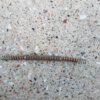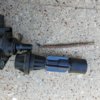Maisonvi
Grass-Roots Vendor
Here is my quick and simple write up on how to do the copper coil pack mod. The point of this is to replace the steel springs that are in your coil pack with something a bit more conductive and robust. If you are BT and experiencing spark blow out, this maybe what you need to help open your plugs back up.
This is how I did it. You can probably do it with less tolerance and tools, but I’m a bit OCD when it comes to this type of thing.
Things you will need:
8mm socket
Approximately 1 foot of 4-gauge solid copper wire (Home Depot, Lowes, Menards should all have this)
A hack saw
A cordless drill motor
Files
Calipers (a fine resolution scale will work too, but I like the accuracy of calipers and you can get some from harbor freight for around $10 that will work fine)
Bench vice

Step 1: Pull all 4 of your Coils from your car. If you have a TMIC or FMIC piping in the way, that will have to go. Un-plug all 4 connectors and remove the one screw holding down each coil pack. They should then come right out.
Step 2: Straighten out the copper coil as best you can (the straighter the better. You will see how well you did in step 4). Clamp the copper in the vice leaving yourself room to mark and cut it. Take your scale or calipers and make a mark at 2 and 5/8” on the copper rod.
Step 3: Carefully with the hacksaw, cut just to the long side of the mark you made. Cut too close and the rod will be too short. Cut it too long and you will have to spend more time later taking it down. I went just to the other side of my Sharpie line

Step 4: Put the cut piece in the drill chuck. This is where you will see how straight you made the copper. If it’s spinning all over the place you didn’t get it very straight. It doesn’t have to be perfect, but I tried to get mine spinning as round as possible.

Step 5: Clamp your file pointing vertically in the vice. You don’t have to crank on it super hard, shouldn’t really go anywhere.

Step 6: Using the drill, chamfer the edges and put the flat end up against the file as it spins to “machine” down the ends. Once you have gotten both ends cleaned up and flat check the length. Repeat until you get the correct length. If you so feel inclined I cleaned mine up with a bit of sand paper and scotchbrite when I was done.



Step 7: Disassemble the coil. The bottom half should just pull apart from the upper section. Inside you can remove the spring. Press the copper rod into the top half until it makes contact with the internals. I put a bit of conductive grease on the end of it to aid in conductivity as well.


Step 8: Reassemble the coils, and reinstall them. Should be good to go now with more spark!
This is how I did it. You can probably do it with less tolerance and tools, but I’m a bit OCD when it comes to this type of thing.
Things you will need:
8mm socket
Approximately 1 foot of 4-gauge solid copper wire (Home Depot, Lowes, Menards should all have this)
A hack saw
A cordless drill motor
Files
Calipers (a fine resolution scale will work too, but I like the accuracy of calipers and you can get some from harbor freight for around $10 that will work fine)
Bench vice

Step 1: Pull all 4 of your Coils from your car. If you have a TMIC or FMIC piping in the way, that will have to go. Un-plug all 4 connectors and remove the one screw holding down each coil pack. They should then come right out.
Step 2: Straighten out the copper coil as best you can (the straighter the better. You will see how well you did in step 4). Clamp the copper in the vice leaving yourself room to mark and cut it. Take your scale or calipers and make a mark at 2 and 5/8” on the copper rod.
Step 3: Carefully with the hacksaw, cut just to the long side of the mark you made. Cut too close and the rod will be too short. Cut it too long and you will have to spend more time later taking it down. I went just to the other side of my Sharpie line

Step 4: Put the cut piece in the drill chuck. This is where you will see how straight you made the copper. If it’s spinning all over the place you didn’t get it very straight. It doesn’t have to be perfect, but I tried to get mine spinning as round as possible.

Step 5: Clamp your file pointing vertically in the vice. You don’t have to crank on it super hard, shouldn’t really go anywhere.

Step 6: Using the drill, chamfer the edges and put the flat end up against the file as it spins to “machine” down the ends. Once you have gotten both ends cleaned up and flat check the length. Repeat until you get the correct length. If you so feel inclined I cleaned mine up with a bit of sand paper and scotchbrite when I was done.



Step 7: Disassemble the coil. The bottom half should just pull apart from the upper section. Inside you can remove the spring. Press the copper rod into the top half until it makes contact with the internals. I put a bit of conductive grease on the end of it to aid in conductivity as well.


Step 8: Reassemble the coils, and reinstall them. Should be good to go now with more spark!
Last edited:


